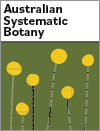
Australian Systematic Botany
Volume 35 Number 4 2022
Some genera in Myrtaceae have been grouped with taxa without apparent shared features with common evolutionary origins. To address this, we analysed an expanded DNA dataset in combination with data from morphology, and reassessed relationships of the genera Kania, Xanthomyrtus and Cloezia. As a result, the tribe Kanieae was redefined as monogeneric, the genera formerly grouped with it were assigned to the new tribe Tristaniopsideae, and the morphological divergence and genetic distance shown by Cloezia and Xanthomyrtus justify placement of them in separate tribes.
SB21032 Abstract | SB21032 Full Text | SB21032PDF (6.4 MB) | SB21032Corrigendum (6.4 MB) | SB21032Supplementary Material (453 KB) Open Access Article
SB21027Understanding Praxelis (Asteraceae, Eupatorieae): an updated taxonomy with lectotypifications and morphological and distributional clarifications
 , Mariana A. Grossi, Rogério N. Ribeiro, Carolyn E. B. Proença and Diego G. Gutiérrez
, Mariana A. Grossi, Rogério N. Ribeiro, Carolyn E. B. Proença and Diego G. Gutiérrez
Praxelis is a genus of weedy and invasive plants from temperate, warm areas of South America. This paper provides an updated taxonomy, clarifies the morphology and distribution, and provides the first key to all the species of the genus. This contribution is part of an ongoing study of the highly invasive P. clematidea, and the subtribe Praxeline.
The genus Pogonolepis comprises an otherwise morphologically indistinguishable pair of one outcrossing and one non-outcrossing species. I generated sequence capture data to test the genetic segregation of P. stricta and P. muelleriana and the utility of sequence capture data for species circumscription and diagnostics. Phylogenetic analysis showed the two species to form two specimen clades, supporting the current taxonomy, but contrary to expectations, non-outcrossing P. muelleriana exhibited lower gene concordance than its outcrossing sister species.
SB22010 Abstract | SB22010 Full Text | SB22010PDF (2.9 MB) | SB22010Corrigendum (2.9 MB) | SB22010Supplementary Material (149 KB) Open Access Article
SB22003Phylogeny, classification and biogeography of Philotheca sect. Erionema (Rutaceae) based on nrDNA sequences
 , Daniel J. Murphy, Paul I. Forster, Will C. Neal and Michael J. Bayly
, Daniel J. Murphy, Paul I. Forster, Will C. Neal and Michael J. Bayly 
We present the first DNA analysis of relationships among the 15 species of Philotheca section Erionema. Our results support the current circumscription of six species in the group, suggest that two other species are not distinct from each other and show that two current species contain disparate evolutionary lineages that should be recognised as distinct species. This contributes to knowledge of the diversity and evolution of plants in the Australian flora.
SB22003 Abstract | SB22003 Full Text | SB22003PDF (2.7 MB) Open Access Article
SB22002_COCorrigendum to: Toward a terrestrial biogeographical regionalisation of the world: historical notes, characterisation and area nomenclature
SB22002_CO Abstract | SB22002_COPDF (530 KB) Open Access Article
SB21030_COCorrigendum to: Morphological and molecular evidence refute a broad circumscription for Pultenaea glabra (Fabaceae: Mirbelieae), with implications for taxonomy, biogeography, and conservation
SB21030_CO Abstract | SB21030_COPDF (470 KB) Open Access Article
SB21032_COCorrigendum to: Three new tribes in Myrtaceae and reassessment of Kanieae
SB21032_CO Abstract | SB21032_COPDF (462 KB) Open Access Article
SB21027_COCorrigendum to: Understanding Praxelis (Asteraceae, Eupatorieae): an updated taxonomy with lectotypifications and morphological and distributional clarifications
SB22010_COCorrigendum to: Sequence capture data support the taxonomy of Pogonolepis (Asteraceae: Gnaphalieae) and show unexpected genetic structure
SB22010_CO Abstract | SB22010_COPDF (463 KB) Open Access Article



